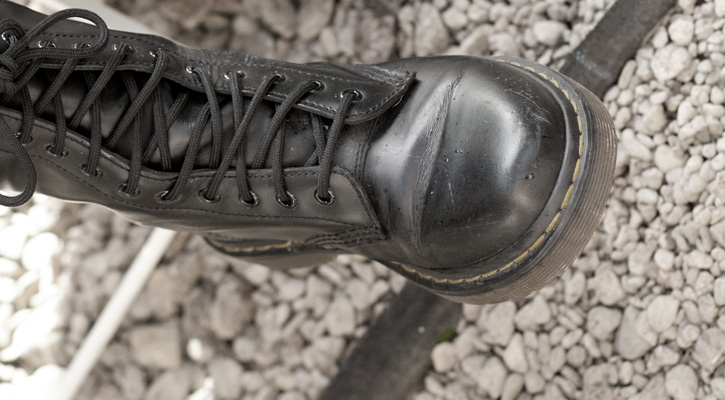
When choosing between Dr. Martens and Timberland boots, it depends on what you value most in footwear.
Dr. Martens are perfect if you’re looking for a fashion-forward choice with a rich history and unique styling. Known for their comfort and rebellion-style credibility, they are a staple in many wardrobes around the world.
Timberland boots, on the other hand, are known for their durability and practical use, making them a favorite among those who need reliable footwear for outdoor activities. They offer a rugged look that can handle various weather conditions, which is ideal for anyone needing tough and long-lasting boots.
Both options come with their strengths. Whether you prioritize style or function, there’s a boot for you.
Explore which aspects matter most to you as you find the best fit for your lifestyle.
History and Brand Overview
The video will be loaded from YouTube.com, a third party. If you play it, you accept their terms of service, and their use of cookies.
Dr. Martens and Timberland have unique beginnings and philosophies that shape their shoes today. You will discover how Dr. Martens originated with a purpose of comfort and durability, while Timberland emerged with a focus on outdoor adventures and practicality.
The Origin of Dr. Martens
Dr. Martens traces its roots back to Germany in 1945. The brand was born when Klaus Märtens, a German army doctor, sought to create a comfortable shoe for his injured foot.
Märtens teamed up with his friend, Dr. Herbert Funck, and they developed a unique air-cushioned sole.
In 1960, the first pair of Dr. Martens boots, now known as 1460s, rolled off the production line in the UK. These boots became popular with workers due to their durability and comfort. The brand soon became iconic among subcultures, like punk and grunge, due to their distinct style.
Key Points:
- Origin: Germany
- First Boots: Launched in the UK, in 1960
- Noted For: Comfort and cultural icon
The Timberland Journey
Timberland started in 1928, initially known as the Abington Shoe Company in Massachusetts. In 1973, the Timberland brand was officially introduced with its waterproof leather boot.
These boots were designed to withstand harsh weather conditions, making them favorites in outdoor environments.
Timberland focused on quality craftsmanship and innovation. The brand expanded its line to include rugged footwear and outdoor apparel. Timberland is respected for its environmental efforts and sustainable practices, which have become central to its brand identity.
They now produce a range of fashionable boots suitable for both work and casual wear.
Key Points:
- Founded: 1928, Massachusetts
- Timberland Brand Launched: 1973
- Known For: Waterproof technology and sustainability
Design and Aesthetics
The video will be loaded from YouTube.com, a third party. If you play it, you accept their terms of service, and their use of cookies.
When it comes to design, Dr. Martens and Timberland boots offer distinct styles and materials. From classic 1460 boots to diverse uses of leather, these footwear options appeal to different tastes.
Classic Styles
Dr. Martens is famous for its iconic 1460 boot. This boot features an 8-eyelet design and a sleek silhouette. It often comes in smooth leather, which gives it a polished look. You might also find them in bold colors, adding to their unique style.
Timberland boots, especially the classic 6-inch boot, are known for their sturdy design. They usually have a more rugged appearance. The use of nubuck leather creates a distinctive look and feel. Timberland boots are often crafted to highlight both function and fashion.
Both brands lean heavily into their signature styles, making each instantly recognizable. Dr. Martens’ classic styles are often perceived as edgy and urban. Timberlands, meanwhile, are seen as reliable and outdoorsy, striking a perfect balance between aesthetics and practicality.
Material and Construction
Dr. Martens uses premium leather, with smooth and shiny finishes. Their boots often have Goodyear welt construction, enhancing durability. This method involves a heat-sealed, stitched welt for long-lasting wear. Dr. Martens also offers vegan options made from synthetic materials, appealing to eco-conscious buyers.
Timberland boots are crafted with high-quality materials such as nubuck and suede. The thick leather and seam-sealed construction keep your feet dry and comfortable. Timberland’s boots often have padded leather collars for extra comfort. Their craftsmanship ensures they stand up well to various weather conditions.
The focus on quality materials is evident in both brands. Dr. Martens impresses with its polished leather, suitable for urban environments. Timberland shines with its rugged leather, perfect for outdoor adventures. Both options provide style and durability, meeting different preferences in footwear.
Comfort and Fit
When deciding between Dr. Martens and Timberland boots, comfort is key. Consider the break-in period, cushioning provided by insoles, and the level of arch support.

Break-In Period
Dr. Martens are known for having a longer break-in period. The leather can feel stiff at first, so you might experience some discomfort initially.
Over time, the leather softens, giving a snug fit. Wearing them around the house with thick socks can help speed up this process.
Timberlands, on the other hand, tend to be more comfortable from the start. The softer leather and padding inside mean they often require less time to become comfortable. This makes them a more convenient choice if you need boots ready to wear right away.
Insole and Cushioning
Dr. Martens often come with air-cushioned soles. These soles help absorb shock and provide a bouncy feel as you walk. This feature can reduce strain on your feet during long days.
In contrast, Timberland boots include anti-fatigue technology in their insoles. This technology is designed to return energy to your feet, which can be especially helpful if you’re on your feet for extended periods. The insoles are usually well-cushioned, enhancing overall comfort while wearing the boots.
Arch Support
Dr. Martens offer moderate arch support. If you have high arches, you might need additional insoles for extra support.
The boots are generally suitable for those with average arch needs. Their rubber soles provide stability and grip, adding to the comfort levels.
Timberland boots are known for providing better arch support. This can be beneficial if you require more structured support. The design helps evenly distribute weight, which can reduce fatigue and discomfort during use. If arch support is essential for you, Timberlands might be a better fit.
Functionality and Performance
When comparing Dr. Martens and Timberland boots, you’ll want to consider their suitability for outdoor activities and rugged use.
Understanding their waterproof features and durability can help you choose the right pair for work or play. These aspects can affect how well they perform in different environments and tasks.

Outdoor Versatility
Timberland boots are often seen as a top choice for outdoor versatility. Their design focuses on providing grip and support on various terrains. The rubber outsole of Timberland boots gives you good traction, whether you’re hiking in the woods or navigating slick city streets.
Dr. Martens boots, typically, aren’t crafted with outdoor adventures in mind. They’re more suitable for casual wear. While they offer style and comfort for everyday urban settings, their grip and support may not hold up for demanding outdoor activities like hiking.
Waterproof Features
When it comes to keeping your feet dry, Timberland boots shine. Many of their styles include waterproofing technology that prevents water from seeping into the boots.
This makes them great for wet conditions and ensures your feet remain dry during rainy weather or when you step into puddles.
Dr. Martens, on the other hand, may not focus on waterproofing in the same way. Although some styles offer water-resistant materials, they’re not always fully waterproof. If consistent exposure to wet conditions is a concern for you, Timberland boots may be a better option.
Durability for Work and Play
Regarding durability, both brands have strengths, but they cater to slightly different needs.
Timberland boots are known for their rugged construction and ability to withstand heavy use. They’re popular as work boots and often feature reinforced stitching and sturdy materials, making them ideal for demanding jobs or rough terrain.
Dr. Martens boots are praised for their robust design, especially in urban environments. They are known for their durable shoes, with a focus on longevity in everyday wear.
While they might not be the go-to choice for intense physical labor or challenging outdoor conditions, they’re favored for style and long-lasting wear in more casual settings.
Sustainability and Care
When deciding between Dr. Martens and Timberland boots, consider eco-friendliness and how you can maintain your boots to last longer. Dr. Martens offer some vegan options while Timberland focuses on sustainable materials. Proper care can extend the life of any boot brand.
Eco-Friendly Practices
Dr. Martens has taken steps toward sustainability by offering vegan boots. These boots are made without any animal products, appealing to those looking for cruelty-free options. They also focus on reducing waste and improving their manufacturing process to lower their environmental impact.
Timberland is known for its commitment to the environment. They use responsibly sourced leather and have implemented recycling initiatives to reduce waste. Some Timberland boots feature recycled materials, such as plastic bottles turned into linings or soles, highlighting their approach to eco-friendly manufacturing.
Maintenance and Longevity
Proper maintenance is key to making your boots last.
Dr. Martens recommends using their Wonder Balsam to condition the leather and protect it from water and stains. Regular cleaning and using a damp cloth can also help remove dirt, keeping your boots looking fresh.
Timberland encourages routine care by suggesting leather cleaners for their boots. They advise applying waterproofing sprays to protect the material from moisture. Rotating your boots to avoid continuous wear can help them retain their shape and extend their life. Taking these steps ensures both brands will serve you well over time.
Price Comparison and Value
When deciding between Dr. Martens and Timberland boots, it’s important to look at both their prices and the value they offer. Consider if they are worth the investment and how the cost holds up over time.
Investment Worthiness
Dr. Martens typically range from $100 to $200. They are known for their durability and style, making them a strong fashion statement. If you value iconic design and comfort, these boots can be a worthwhile investment.
Timberland boots, on the other hand, fall within a similar price range, often between $130 and $250. They are praised for their ruggedness and are great for outdoor use. If you need boots that can withstand tough conditions, Timberlands might offer greater value for your needs.
Cost Over Time
Both Dr. Martens and Timberland boots are built to last, which affects their long-term cost.
Dr. Martens’ air-cushioned soles and leather construction often mean fewer replacements, making them cost-effective over years of regular use.
Timberland boots generally feature waterproof technologies and durable materials that handle wear and tear well.
While initial costs are higher, the lower rate of repairs and replacements provides substantial savings over time.
When considering both options, think about your lifestyle and usage to determine which boot offers better value for consistent wear.
Both brands have proven their quality, but your personal needs will drive your best choice.
